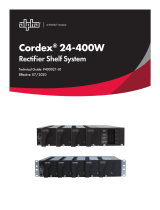
Refer to the back of this manual for Factory Service and Technical Support contact information
0350046-J0 Rev C Page 12 of 127
3.6 Battery Temperature Compensation
The automatic battery temperature compensation (Temp Comp or TC) will function with Cordex series rectifiers
that support CAN bus communications and Pathfinder series rectifiers that support RS-485 remote
communications.
Temp Comp may be active in either float (4.3.1) or equalize (4.3.2) mode.
Temperature inputs are available on the CXC for monitoring a lead acid battery string. Temperature sensor
readings can be displayed on the GUI in either Celsius (°C) or Fahrenheit (°F) scales.
The CXC will have the flexibility to display the breakpoints in voltage as well as temperature, also enabling them
to be entered as voltage or temperature. However, it should be noted that the “Upper Breakpoint” must be used
for the higher-temperature setting (lower voltage), and “Lower Breakpoint” must be the lower temperature (higher
voltage). Confusing these will cause the temperature compensation feature to function incorrectly.
The detection of thermal runaway will be limited to a programmable Battery Over Temperature Alarm. This will
enable the Supervisor to select a temperature that will trigger an alarm.
3.6.1 Theory of Battery Temperature Compensation
Battery life expectancy and performance is directly related to battery ambient temperature. The optimum
temperature for battery operation is 25°C (77°F). Without compensation, battery life is seriously compromised at
temperatures above 25°C, while battery performance is reduced below it.
Adjusting the battery’s float or equalize voltage to correspond with temperature fluctuations will ensure maximum
battery performance and life expectancy. With the CXC, this may be accomplished by using the software’s built-in
automatic temperature compensation function.
This function works by adjusting the system, every ten minutes, as the temperature changes and provides for a
maximum voltage change of 0.1V over this interval.
While this may seem like a small voltage change, even if the battery had a temperature compensation slope as
high as 5.5mV per °C, the CXC would still be able to track a temperature change in the battery of up to 4.5°C or
8°F per hour. Due to the large thermal mass of the battery string, even an extreme rise or drop in environmental
temperature would be very unlikely to cause this kind of temperature change in the battery over a one hour
period.
Temp Comp occurs at standard rates commonly referred to as slope-compensation settings. For maximum
performance, it’s important to match the battery slope compensation with the setting recommended by the battery
manufacturer. This is not to be confused with slope regulation; which refers to the process of regulating current
among a group of parallel-operating rectifiers.
The Temp Comp feature has programmable breakpoints. These are the points at which Temp Comp will cease.
Further temperature decreases or increases will NOT increase or decrease the output voltage. This protects the
connected load from excessive voltage conditions. As Temp Comp is active in either float or equalize mode,
breakpoints should be set with this in mind.
The Temp Comp feature also incorporates fail-safe circuitry to prevent it from driving the rectifier system to a
voltage higher than is suitable for the load or battery.
3.6.2 Operation of Battery Temperature Compensation
The CXC can accommodate up to four sensors for lead acid battery temperature monitoring. If more than one
probe is used and the temperature readings are within 5°C (9°F) of one another, the temperature readings will be
calculated for the average. If the readings difference exceeds 5°C, it is assumed that thermal runaway is
occurring in one battery string and the calculation changes from average to the highest reading. If any reading is
suddenly outside the norm (i.e. cut leads or open leads), that reading is discarded and the associated Temp
Sensor Fail alarm is issued. The temperature calculation will then return to the average of the remaining sensors,
or next highest reading.
Temp Comp has been programmed as a low priority item; all commands and operations will take precedence
over Temp Comp. If a command is issued during a Temp Comp cycle, the cycle will be put on hold until the
command is completed. If any operation is happening when the Temp Comp cycle occurs, the cycle will be put on
hold until the operation is completed. Temp Comp will resume when the command or operation is completed.
The Temp Comp feature can be enabled or disabled in the CXC’s Batteries menu.





















